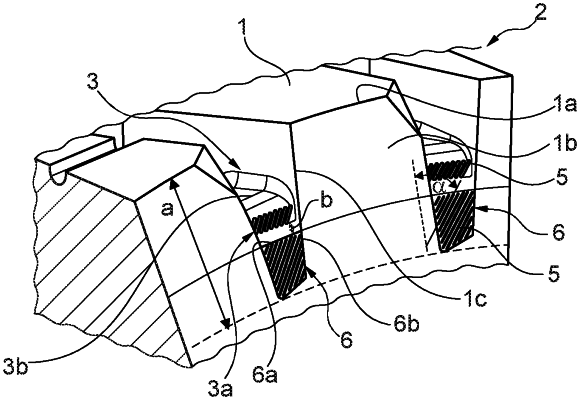| CPC B60C 11/01 (2013.01) [B60C 23/19 (2013.01); B60C 2011/013 (2013.01); B60C 2200/06 (2013.01)] | 12 Claims |

|
1. A pneumatic vehicle tire comprising a carcass having at least one ply, a multi-ply belt or breaker, and a profiled tread with grooves formed to a profile depth, wherein the profiled tread is provided at tire shoulders a shoulder-side block row;
wherein blocks of the shoulder-side block row each have a one of a peripheral edge laterally delimiting the ground contact patch of the pneumatic vehicle tire, or a shoulder rounding with a radius of up to 30.0 mm;
wherein shoulder flank surfaces that extend in a radial direction adjoin the peripheral edges or the shoulder roundings, and wherein, in the case of shoulder roundings, an imaginary section line is defined between an envelope of the tread that is continued beyond the shoulder rounding and the shoulder flank surface that is continued beyond the shoulder rounding;
wherein the shoulder flank surfaces are provided, at in particular regular intervals over a circumference of the pneumatic vehicle tire and within a distance of 1.25 times to 2.5 times the profile depth from the respective peripheral edge or, in the case of shoulder roundings, from an imaginary section line; and,
wherein the blocks shoulder-side block rows are separated from one another by transverse grooves that open outward at the shoulder flank surface, wherein groove bottoms of the transverse grooves have end portions that extend in the radial direction over 10% to 30% of the profile depth and are offset inwardly with respect to the shoulder flank surface, the end portions likewise being provided with the ribs that do not project beyond the level of the shoulder flank surfaces;
the end portion of each transverse groove comprises an upper recess and a lower recess separated by a radial distance of at least 2.0 mm;
the upper recess and the lower recess comprising cooling ribs arranged at an angle alpha, the angle alpha configured to facilitate heat dissipation while the tire is rolling, the above recess having less than half the surface area of the other recess of the at least two recesses and separated by a distance b.
|